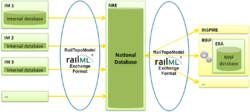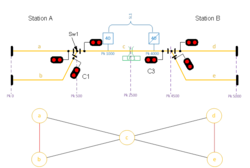RTM quick start: Difference between revisions
Jump to navigation
Jump to search

| [checked revision] | [checked revision] |
Ferri Leberl (talk | contribs) |
Ferri Leberl (talk | contribs) (Anpassung Navi) |
||
| Line 12: | Line 12: | ||
{{navi | {{navi | ||
|chapterlink=RTM | |chapterlink=RTM quick start | ||
|nextlink=RTM for your business | |nextlink=RTM for your business | ||
|chapter={{RTM}} | |chapter={{RTM}} quick start | ||
|next={{RTM}} for your business | |next={{RTM}} for your business | ||
|lesson=This page is just a quick introduction | |lesson=This page is just a quick introduction | ||
|nchapter={{rtm}} Modelling Concepts | |||
|nchapterlink=RTM Modelling Concepts | |||
}} | }} | ||
Revision as of 13:13, 13 March 2017
RailTopoModel® For Your Business

Ideal national situation with the RailTopoModel® and railML® (© IIRC)
In this section you will find answers to the question why you should use the RailTopoModel® for your specific data modelling and exchange problem. See RTM For Your Business for more details.
RailTopoModel® For IT Architects and Developers
This section addresses the software developers of the companies that want to implement a RailTopoModel® based asset database. A simple example shows how to get from the real infrastructure to the RailTopoModel® representation. See RTM for IT Architects and Developers for more details.
| ||||
| ||||
| railML® 2 Wiki – railML® 3 Wiki |

